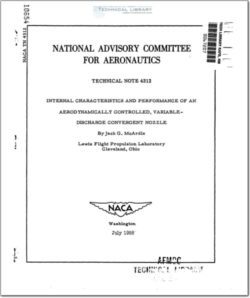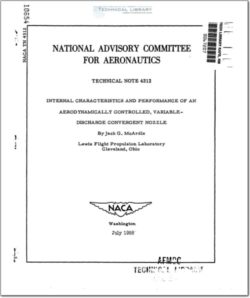NACA-TN-4312

- Version
- 231 Downloads
- 978.85 KB File Size
- 1 File Count
- December 4, 2015 Create Date
- December 4, 2015 Last Updated
National Advisory Committee for Aeronautics, Technical Notes - Internal Characteristics and Performance of an Aerodynamically Controlled Variable Discharge Convergent Nozzle

The effective flow area of a convergent exhaust nozzle was reduced
by injecting a high-pressure secondary Jet into the nozzle near the exit.
Analytical expressions relating the performance with significant design
and operating variables were developed, and necessary experimental fac-
tors were evaluated by using a 4—inch-exit-diameter nozzle with unheated
pressurized air discharged to the atmosphere. The effective flow area
was reduced as much as 67 percent, while the ratio of actual thrust to
the thrust attainable from primary and secondary isentropic expansion
was 0.94 or better in nearly all cases. Some of the configurations,
altered to operate as Jet deflectors, produced significant values of
side force but, at the same time, operated at reduced effective flow
area.
Modern turbojet engines often use variable—area primary exhaust
nozzles to help keep thrust high and specific fuel consumption low under
all operating conditions. Nozzle area usually is varied by mechanically
adjusting the exit to the required size by means of interconnected
leaves. However, the effective flow area of a fixed nozzle can be con-
tinuously'varied over a wide range by‘suitably injecting a secondary Jet
into the nozzle. This.method, which is equivalent to mechanical exit
variation and could eliminate problems arising from weight, complexity;
and actuator power, is reported to be in operational use in France
(ref. 1).
An investigation of this method of varying the effective flow area
of a convergent nozzle was conducted at the NACA Lewis laboratory; (Ref.
2 gives the results of an independent British investigation of this type
device.) Analytical expressions relating the performance with signifi-
cant operating and design variables were developed. The experimental
coefficients required in these expressions were evaluated by'using a 4-
inch-exit-diameter nozzle with unheated pressurized air discharged to the
atmosphere.
| File | Action |
|---|---|
| naca-tn-4312.pdf | Download |

Comment On This Post